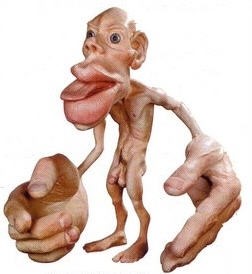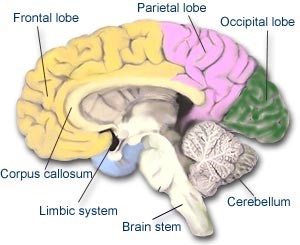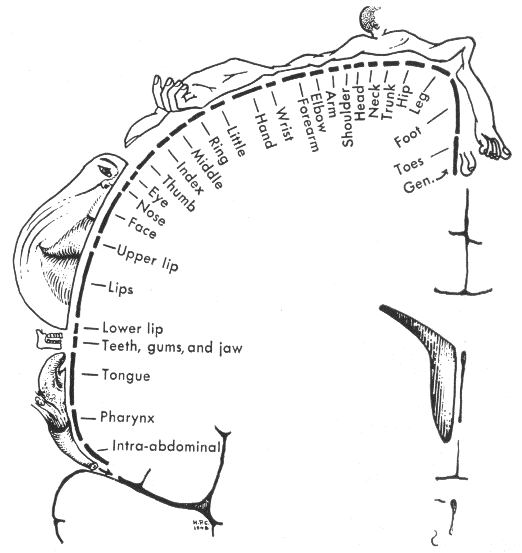By Tenzin Choephel
Tom Sorenson was driving back from a soccer practice when a car in the opposite lane swerved in front of him. When Tom suddenly applied the brake his car spun out of control and was flung from his seat onto the ice plant bordering the freeway. As he was hurled through the air, Tom looked back and saw that his hand was still in the car, “gripping” the seat cushion-severed from his body. As a result of that accident, Tom lost his left arm just above the elbow. In the weeks afterward, even though he knew his hand was gone, he could still sense it’s presence below the elbow. He could wiggle his fingers and reach out to things that were within his invisible arms reach. To Toms mind, his arm is still intact. Now this is not something straight out of a Hollywood thriller. It is real!

Image: Homunculus (www.madscientistblog.ca)
Having said this, one might then call Tom crazy. Neuroscientists don’t think so. His impression that his arm is still there is a classic instance of what is known as Phantom Limb-an arm or leg that stays in the patient’s mind long after it has been amputated. In addition to phantom arms and legs which are quite common, there have also been cases of phantom penis and phantom breasts!
Persistence of sensations in the limbs long after amputation had been noticed as far back as the sixteenth century by the French surgeon Ambroise Pare. There is a certain folklore surrounding this mysterious phenomenon. After Lord Nelson lost his right arm during an unsuccessful attack on Santa Cruz de Tenerife, he experienced intense pain in his phantom limb. This led him to declare that his phantom “was direct experience for the existence of the soul”. If an arm can exist after it has been cut off, why can’t the whole person survive death? Lord Nelson claimed this to be an incontrovertible proof of the existence of the spirit that sheds its physical body and persists. What really is the reason behind this?
There have been mixed reactions among the members of medical community on this rather spooky phenomenon. Many people have called this a wishful thinking and contended that it was because the patient desperately desired his limb back that he experienced the phantom.
Later, physicians came up with a seemingly more agreeable explanation, the one which medical students are still taught as the reason for the phantom: the frayed and curled-up nerve endings in the stump that originally connected to the hand tend to become inflamed and irritated, hence fooling higher brain centers into thinking that the missing limb is still there. V S Ramachandran believes nothing can be farther from the truth. He believes that it has to do with the remapping of the patient’s brain.
Dr. Ramachandran is a world-renowned neuroscientist and professor and director of the center for Brain and Cognition at University of California, San Diego. His rise to fame has been due to his ground breaking work on the elusive Phantom Limb Syndrome. But before we look at what he has to say it would be unwise on my part not to show the reader a rough map of the jelly that sits inside my head…everybody’s head indeed.
An extremely brief tour of the brain
The parts cleanly divided down the middle into left and right parts are called Cerebral Hemispheres. The beans-like structure on the lower right is Cerebellum. There is one on each hemisphere. The large convoluted (and most porridge-like) portion on the top is referred to as Cerebrum. The comparatively thin outer surface layers of cerebellum and cerebrum are called grey matter. The larger inside regions are called white matter. The grey matter of cerebrum is called cerebral cortex. The grey matter of cerebellum is called Cerebellar cortex. The cerebrum receives information from all the sense organs. The primary regions of the cerebral cortex are Visual Cortex, Somato-Sensory cortex, motor cortex, auditory cortex and olfactory cortex.

Human brain details (www.madscientistblog.ca)
The touch signals from the entire skin surface on the left side of the human body are mapped onto the right cerebral hemisphere on a vertical strip of cortical tissue called Post-Central-gyrus. Although there are several maps, but we may consider only the one proposed by the Canadian surgeon Wilder Penfield and popularly called Penfield Homunculus. He performed many surgeries on patients under anesthetics. He split open the brains of the patients who were literally conscious (during the surgery the patient wont feel any pain as there are no pain receptors in the brain!) and stimulated the various points on the brains and asked for the patients’ response as to the corresponding sensations on the various parts of their bodies. Among other things, he found this famous map. The various parts of our body could be mapped onto the Post central gyrus in the form of a strange, highly distorted man (3D graphic at the beginning of the article) draped on it. See the figure below for the drape. If you stimulate the part where the hand is located you will feel a sensation on your real hand. If you stimulate the lip you will feel your lip being touched. Surprised? Look at this: “this can be tried practically”.

Penfield map of the brain (www.neurobiography.info)
And getting back to the mystery…
Dr. Ramachandran says in his BBC Reith Lectures that he once had a patient whose arm had been amputated above the left elbow. The patient sat in his office blind-folded while Rama touched different areas of the patient’s body and asked him to say where he was touching him. All went as expected until Rama touched his left cheek, at which point the patient exclaimed, ‘oh my god, you are touching my left thumb,’ his missing phantom thumb, in other words. His line of reasoning goes thus: when the hand is amputated no signals are received by the part of the brain’s cortex corresponding to the hand. It becomes hungry for sensory input and the input from the facial skin now invades the adjacent vacated area corresponding to the amputated hand. Signals from the facial skins are then misinterpreted by higher centers of the brain as coming from the missing hand!
Victor, one of Dr Ramachandran’s patients, when water was poured down his cheek, felt it trickling down his Phantom arm too. He raised his hand and felt the water running up-that’s in defiance of the laws of physics! Welcome to the land of confused neurons.
He has tested this hypothesis called ‘Remapping’ or ‘Cross wiring’ using MEG or magneto encephalography, a brain imaging technique. When various parts of the body are touched, this technology shows which areas are stimulated in the brain. In a normal person, touching his facial skin activates only the facial region on the cortex. However in Victor’s case, it activated both the facial and the hand area of the Penfield map. This proves there has been some cross wiring in Victor’s brain after his amputation.
Now in Tom’s case, every time he smiles or experiences some spontaneous activity of facial nerves,that activates his hand area, thereby fooling him into thinking that his hand is still there. QED.
Carcinoma (a kind of cancer) of the penis is sometimes treated with amputation and many of these patients experience phantom penis-sometimes even phantom erection! Look at the Penfield map again. See that the foot lies next to the penis area. In Dr. Ramachandran’s words--would such patients find tap-dancing especially enjoyable?
Up until sometime ago it was believed and taught in medical schools that once connections in the brain are set in the fetus or in early infancy there is nothing much that can be done to change these in an adult brain. That is the reason cited for the little recovery of function when there is damage to the nervous system and the notorious difficulty in treating the diseases of the brain. But this cross wiring phenomenon unveiled by Dr. Ramachandran and his team at UCSD flatly contradicts this. They have shown through their research that the even an adult human brain is capable for immense ‘plasticity’ or malleability. The brain can change. This reminded me of something I had read in the Art of Happiness by HH the Dalai Lama and Howard C. Cutler. Cutler writes:
This remarkable feature of the brain appears to be the physiological basis for the possibility of transforming our minds. By mobilizing our thoughts and practicing new ways of thinking, we can reshape our nerve cells and change the way our brains work. It is also the basis for the idea that inner transformation begins with learning (new input) and involves the discipline of gradually replacing our negative conditioning (corresponding with our present characteristic nerve cell activation patterns) with positive conditioning (forming new neural circuits). Thus the idea of training the mind for happiness becomes a very real possibility.
References:
- The Emerging Mind by VS Ramachandran.
- The Phantoms in the Brain by VS Ramachandran with Sandra Blackslee.
- The Art of Happiness, HH the Dalai Lama with Howard C Cutler.

